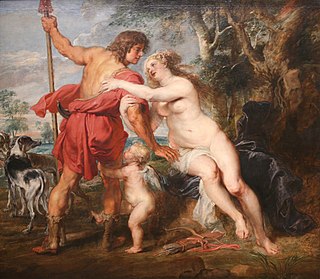
The Baroque is a style of architecture, music, dance, painting, sculpture and other arts that flourished in Europe from the early 17th century until the 1740s. In the territories of the Spanish and Portuguese empires including the Iberian Peninsula it continued, together with new styles, until the first decade of the 1800s. It followed Renaissance art and Mannerism and preceded the Rococo and Neoclassical styles. It was encouraged by the Catholic Church as a means to counter the simplicity and austerity of Protestant architecture, art and music, though Lutheran Baroque art developed in parts of Europe as well.

Renaissance architecture is the European architecture of the period between the early 14th and early 16th centuries in different regions, demonstrating a conscious revival and development of certain elements of ancient Greek and Roman thought and material culture. Stylistically, Renaissance architecture followed Gothic architecture and was succeeded by Baroque architecture. Developed first in Florence, with Filippo Brunelleschi as one of its innovators, the Renaissance style quickly spread to other Italian cities. The style was carried to Spain, France, Germany, England, Russia and other parts of Europe at different dates and with varying degrees of impact.

The architecture of cathedrals and great churches is characterised by the buildings' large scale and follows one of several branching traditions of form, function and style that derive ultimately from the Early Christian architectural traditions established in Late Antiquity during the Christianization of the Roman Empire.

Baroque architecture is a highly decorative and theatrical style which appeared in Italy in the early 17th century and gradually spread across Europe. It was originally introduced by the Catholic Church, particularly by the Jesuits, as a means to combat the Reformation and the Protestant church with a new architecture that inspired surprise and awe. It reached its peak in the High Baroque (1625–1675), when it was used in churches and palaces in Italy, Spain, Portugal and France, and Austria. In the Late Baroque period (1675–1750), it reached as far as Russia and the Spanish and Portuguese colonies in Latin America, Beginning in about 1730, an even more elaborately decorative variant called Rococo appeared and flourished in Central Europe.
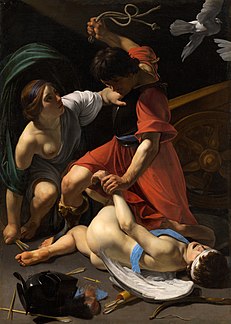
The Caravaggisti were stylistic followers of the late 16th-century Italian Baroque painter Caravaggio. His influence on the new Baroque style that eventually emerged from Mannerism was profound. Caravaggio never established a workshop as most other painters did, and thus had no school to spread his techniques. Nor did he ever set out his underlying philosophical approach to art, the psychological realism which can only be deduced from his surviving work. But it can be seen directly or indirectly in the work of Rubens, Jusepe de Ribera, Bernini, and Rembrandt. Famous while he lived, Caravaggio himself was forgotten almost immediately after his death. Many of his paintings were reascribed to his followers, such as The Taking of Christ, which was attributed to the Dutch painter Gerrit van Honthorst until 1990. It was only in the 20th century that his importance to the development of Western art was rediscovered. In the 1920s Roberto Longhi once more placed him in the European tradition: "Ribera, Vermeer, La Tour and Rembrandt could never have existed without him. And the art of Delacroix, Courbet and Manet would have been utterly different". The influential Bernard Berenson stated: "With the exception of Michelangelo, no other Italian painter exercised so great an influence."

Illusionistic ceiling painting, which includes the techniques of perspective di sotto in sù and quadratura, is the tradition in Renaissance, Baroque and Rococo art in which trompe l'oeil, perspective tools such as foreshortening, and other spatial effects are used to create the illusion of three-dimensional space on an otherwise two-dimensional or mostly flat ceiling surface above the viewer. It is frequently used to create the illusion an open sky, such as with the oculus in Andrea Mantegna's Camera degli Sposi, or the illusion of an architectural space such as the cupola, one of Andrea Pozzo's frescoes in Sant'Ignazio, Rome. Illusionistic ceiling painting belongs to the general class of illusionism in art, designed to create accurate representations of reality.
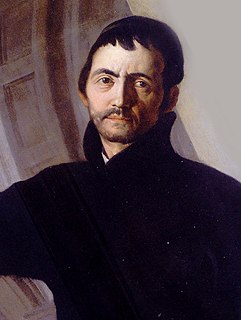
Andrea Pozzo was an Italian Jesuit brother, Baroque painter and architect, decorator, stage designer, and art theoretician.
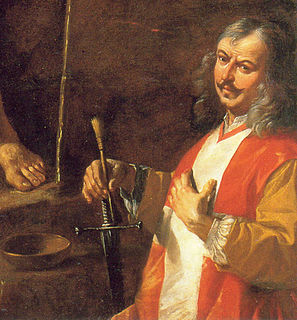
Mattia Preti was an Italian Baroque artist who worked in Italy and Malta. He was appointed a Member of the Order of Saint John.

Baroque sculpture is the sculpture associated with the Baroque style of the period between the early 17th and mid 18th centuries. In Baroque sculpture, groups of figures assumed new importance, and there was a dynamic movement and energy of human forms—they spiralled around an empty central vortex, or reached outwards into the surrounding space. Baroque sculpture often had multiple ideal viewing angles, and reflected a general continuation of the Renaissance move away from the relief to sculpture created in the round, and designed to be placed in the middle of a large space—elaborate fountains such as Bernini's Fontana dei Quattro Fiumi, or those in the Gardens of Versailles were a Baroque speciality. The Baroque style was perfectly suited to sculpture, with Gian Lorenzo Bernini the dominating figure of the age in works such as The Ecstasy of St Theresa (1647–1652). Much Baroque sculpture added extra-sculptural elements, for example, concealed lighting, or water fountains, or fused sculpture and architecture to create a transformative experience for the viewer. Artists saw themselves as in the classical tradition, but admired Hellenistic and later Roman sculpture, rather than that of the more "Classical" periods as they are seen today.
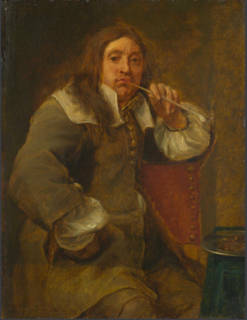
Lucas Faydherbe was a Flemish sculptor and architect who played a major role in the development of the High Baroque in the Southern Netherlands.

Erasmus Quellinus the Younger or Erasmus Quellinus II (1607–1678) was a Flemish painter, engraver, draughtsman and tapestry designer who worked in various genres including history, portrait, battle and animal paintings. He was a pupil of Peter Paul Rubens and one of the closest collaborators of Rubens in the 1630s. Following Rubens' death in 1640 he became one of the most successful painters in Flanders. He was a prolific draughtsman who made designs for decorative programmes in the context of official celebrations, for publications by the local publishers and for tapestries and sculptures realised by the local workshops.
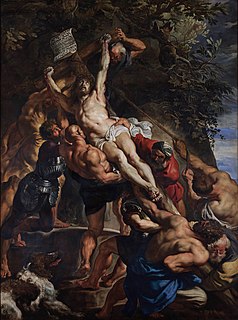
Flemish Baroque painting refers to the art produced in the Southern Netherlands during Spanish control in the 16th and 17th centuries. The period roughly begins when the Dutch Republic was split from the Habsburg Spain regions to the south with the Spanish recapturing of Antwerp in 1585 and goes until about 1700, when Spanish Habsburg authority ended with the death of King Charles II. Antwerp, home to the prominent artists Peter Paul Rubens, Anthony van Dyck, and Jacob Jordaens, was the artistic nexus, while other notable cities include Brussels and Ghent.

Wenceslas Cobergher, sometimes called Wenzel Coebergher, was a Flemish Renaissance architect, engineer, painter, antiquarian, numismatist and economist. Faded somewhat into the background as a painter, he is chiefly remembered today as the man responsible for the draining of the Moëres on the Franco-Belgian border. He is also one of the fathers of the Flemish Baroque style of architecture in the Southern Netherlands.

Sir Peter Paul Rubens was a Flemish artist and diplomat from the Duchy of Brabant in the Southern Netherlands. He is considered the most influential artist of the Flemish Baroque tradition. Rubens's highly charged compositions reference erudite aspects of classical and Christian history. His unique and immensely popular Baroque style emphasized movement, colour, and sensuality, which followed the immediate, dramatic artistic style promoted in the Counter-Reformation. Rubens was a painter producing altarpieces, portraits, landscapes, and history paintings of mythological and allegorical subjects. He was also a prolific designer of cartoons for the Flemish tapestry workshops and of frontispieces for the publishers in Antwerp.

Italian Baroque art is a term that is used here to refer to Italian painting and sculpture in the Baroque manner executed over a period that extended from the late sixteenth to the mid eighteenth centuries.
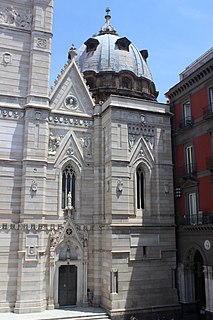
The Royal Chapel of the Treasure of St. Januarius, or the Reale cappella del Tesoro di San Gennaro, is a chapel located in the Cathedral of Naples, Italy, and dedicated to St. Januarius, patron saint of the city. This is the most lavishly decorated chapel in the Cathedral, and contains contributions by the premier Baroque artists in Naples.

Hendrik Frans Verbrugghen or Hendrik Frans Verbruggen was a Flemish sculptor and draftsman, who is best known for his Baroque church furniture in various Belgian churches.
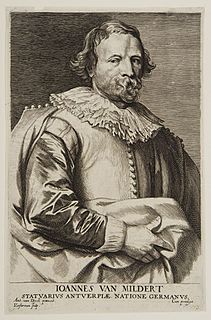
Johannes van Mildert or Hans van Mildert was a Flemish sculptor, who is best known for his baroque sculptures found in many Belgian and Dutch churches.

The St. Paul's Church or Sint-Pauluskerk is a Roman Catholic church located at the Veemarkt in Antwerp. Its exterior is mainly Gothic with a Baroque tower while the interior is characterised by its rich Baroque decoration. It holds paintings by Antwerp's leading artists Peter Paul Rubens, Anthony van Dyck and Jacob Jordaens as well as abundant sculpture and church furniture crafted by leading Antwerp sculptors such as Artus Quellinus the Elder, Pieter Verbrugghen I, Jan Pieter van Baurscheit de Elder, Jan Claudius de Cock and Andries Colyns de Nole. Of particular note is the Calvary outside the Church which is made up of 63 life-size statues and nine reliefs executed in a popular and theatrical style.


















